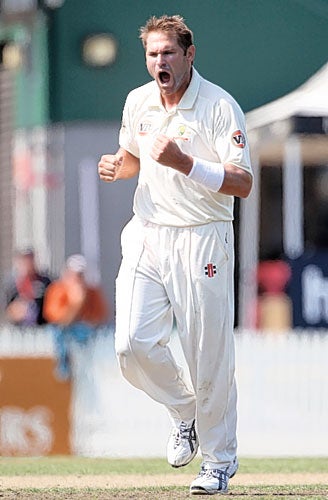Wanted: spicy pitch to give Test cricket a lift
Australia can change bowlers but if Adelaide is a dead track too it will make little difference

Your support helps us to tell the story
From reproductive rights to climate change to Big Tech, The Independent is on the ground when the story is developing. Whether it's investigating the financials of Elon Musk's pro-Trump PAC or producing our latest documentary, 'The A Word', which shines a light on the American women fighting for reproductive rights, we know how important it is to parse out the facts from the messaging.
At such a critical moment in US history, we need reporters on the ground. Your donation allows us to keep sending journalists to speak to both sides of the story.
The Independent is trusted by Americans across the entire political spectrum. And unlike many other quality news outlets, we choose not to lock Americans out of our reporting and analysis with paywalls. We believe quality journalism should be available to everyone, paid for by those who can afford it.
Your support makes all the difference.As the dust – and there was plenty of it – settled on the first Test yesterday the cry went out all over Australia. The Ashes series needs a curator of carnage. True, the appeal was made within the syndicated reports of tabloid newspapers but it may as well have been placed in the situations vacant columns by the International Cricket Council.
The job, far from being connected with the lead role in Night at the Museum 3, refers to a groundsman willing to produce a spicy pitch that might yield a result other than a draw. For all the monumental individual achievements in the opening match of the series at Brisbane the match as a whole can be viewed as a failure for Test cricket.
In the course of five days, 22 wickets fell, only one each on the last two days when pitches are supposed to deteriorate. That The Gabba pitch was prepared by Kevin Mitchell, by common consent the country's most accomplished pitch curator, does not augur well for the next four matches.
The last thing Test cricket needs in a world of Twenty20 is a series of draws that are virtually pre-determined. The Adelaide Oval, where the second Test starts on Friday, has a reputation for being flat rivalled only by X Factor participants.
This is slightly unfair. It is a high-scoring surface and it has a tendency to be too slow, but the last 12 matches have yielded only two draws. Nine of the others have been won by Australia, and one by India.
The worry now is simply that the bowlers of both sides will struggle to take 20 opposition wickets between them to win a match, any match. Australia's problems are probably greater, having taken one English wicket in 152 overs at The Gabba. The selectors responded immediately by adding two fast bowlers to the XI who played in the first Test, Ryan Harris and Doug Bollinger. Having prevaricated for long enough pre-Brisbane before deciding Harris was not fit enough and sending Bollinger away on the morning of the match, their indecision threatens to be final.
There is a tendency on both sides in this series to give the bowlers more credit than they deserve or have earned. But bowling is tough work on benign pitches against batsmen whose technologically advanced tools of trade enable them to hit the ball harder and longer.
At The Gabba, as two partnerships of more than 300 were compiled, many must have questioned their choice of occupation. Careers advisers ought to be informed to tell any young shaver who comes in asking about becoming a bowler that they are being daft and should try something easier like ending world poverty.
It was still slightly surprising to hear Ricky Ponting, the Australia captain, laud Harris so highly. "The fact that he has had such success at international cricket means he's one of those guys that just has to be playing," he said. This made Harris sound like one at the apex of a glittering career who will soon assume his place with the other sporting gods on Mount Olympus.
Harris is a low-slung bowl-all-day type of bowler with a skiddy style, a stocky physique and a temperament to match. But when Ponting referred to his pedigree he was talking about a bowler of 31 who has played 17 one-day internationals and two Tests.
The figures are impressive. In the short game he has taken five wickets in an innings three times, once at The Oval last summer when England were sleepwalking under the lights. His Test matches have yielded nine wickets but then England bowlers have also enjoyed themselves against New Zealand.
Harris is a yeoman cricketer who bats adequately too, but there was a reason he remained unselected at international level until he was 30. Others were better. Whatever Ponting said, Harris is not Glenn McGrath and Dennis Lillee rolled into one. Nor is Bollinger, or Peter Siddle, or Ben Hilfenhaus. Mitchell Johnson might have been but something is happening there which may need more than a few intensive coaching sessions to rectify.
Harris almost made a career in England two years ago. Sussex were delighted to sign him as a Kolpak player with a British passport – he has dual nationality through his dad. But it ended embarrassingly when Harris discovered the arrangement would not allow him to play as a fair dinkum Aussie for Queensland.
Harris said when he was called up: "I like bowling at Adelaide. There is a little bit there early for bowlers and I can come back later and go for reverse swing." He is about to get the chance to prove the point but Australia are floundering.
Join our commenting forum
Join thought-provoking conversations, follow other Independent readers and see their replies
Comments